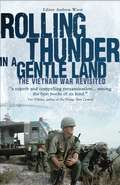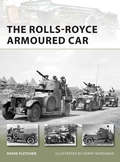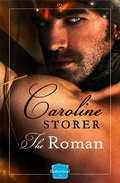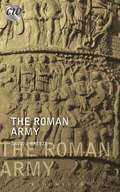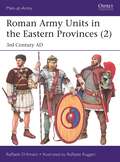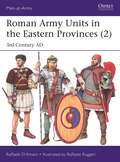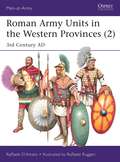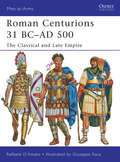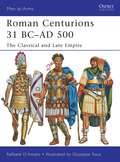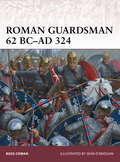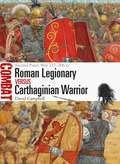- Table View
- List View
Rolling Thunder in a Gentle Land: The Vietnam War Revisited
by Andrew WiestFifteen renowned authors from widely varied backgrounds examine the Vietnam War, providing a fresh insight into this controversial conflict, even for those who have 'read it all before'. First-hand accounts, maps and contemporary photographs, analysis from the soldiers involved and new perspectives from combatants on both sides provide an incisive investigation into a fascinating and terrible war."This is a superb and compelling reexamination of the major historical, political, and ethical issues that continue to smoulder many decades after the conclusion of the Vietnam War, I highly recommend Rolling Thunder in a Gentle Land. It is among the best books of its kind that I've encountered over the last dozen years.†? Tom O'Brien, author of The Things They Carried
The Rolls-Royce Armoured Car (New Vanguard #189)
by David Fletcher Mr Henry MorsheadThe first Rolls-Royce armoured car was a privately owned vehicle fitted with a machine-gun and a limited amount of armour plate, used by the Royal Naval Air Service in Flanders in 1914. By 1915, nearly 100 had been built and turned over to the Army. From then on, as Sir Albert Stern said 'They searched the world for war', operating as far apart as the northwest frontier of India, the Middle East and southern Africa. The cars were fast, quiet and reliable but above all powerful. 'A Rolls in the desert is above rubies,' said Lawrence of Arabia. After World War I, the War Office continued to produce the Rolls-Royce while tinkering with the design. These further cars served all across the Empire, including in Ireland and even later Shanghai, returning for a final brief appearance in the early stages of World War II.This book tells the complete story of the Rolls-Royce Armoured Car, following its design and development as it fought from theatre to theatre during World War I and the turbulent inter-war years.
The Rolls-Royce Armoured Car (New Vanguard)
by Henry Morshead David FletcherThe first Rolls-Royce armoured car was a privately owned vehicle fitted with a machine-gun and a limited amount of armour plate, used by the Royal Naval Air Service in Flanders in 1914. By 1915, nearly 100 had been built and turned over to the Army. From then on, as Sir Albert Stern said 'They searched the world for war', operating as far apart as the northwest frontier of India, the Middle East and southern Africa. The cars were fast, quiet and reliable but above all powerful. 'A Rolls in the desert is above rubies,' said Lawrence of Arabia. After World War I, the War Office continued to produce the Rolls-Royce while tinkering with the design. These further cars served all across the Empire, including in Ireland and even later Shanghai, returning for a final brief appearance in the early stages of World War II.This book tells the complete story of the Rolls-Royce Armoured Car, following its design and development as it fought from theatre to theatre during World War I and the turbulent inter-war years.
The Roman: Harperimpulse Historical Romance
by Caroline Storer‘Full of sexual tension’ Jane Hunt Reviews ROME AD 79 The one woman he ever loved was the one woman who betrayed him. And now, the Roman will have his revenge…
The Roman Army (Classical World)
by David J. BreezeThis authoritative short volume introduces readers to the Roman army, its structure, tactics, duties and development. One of the most successful fighting forces that the world has seen, the Roman army was inherited by the emperor Augustus who re-organized it and established its legions in military bases, many of which survived to the end of the empire. He and subsequent emperors used it as a formidable tool for expansion. Soon, however, the army became fossilized on its frontiers and changed from a mobile fighting force to a primarily defensive body. Written by a leading authority on the Roman army and the frontiers it defended and expanded, this is an invaluable book for students at school and university level, as well as a handy guide for general readers with an interest in military history, the rise and development and fall of the Roman legions, and the ancient world.
The Roman Army (Classical World)
by David BreezeThis authoritative short volume introduces readers to the Roman army, its structure, tactics, duties and development. One of the most successful fighting forces that the world has seen, the Roman army was inherited by the emperor Augustus who re-organized it and established its legions in military bases, many of which survived to the end of the empire. He and subsequent emperors used it as a formidable tool for expansion. Soon, however, the army became fossilized on its frontiers and changed from a mobile fighting force to a primarily defensive body. Written by a leading authority on the Roman army and the frontiers it defended and expanded, this is an invaluable book for students at school and university level, as well as a handy guide for general readers with an interest in military history, the rise and development and fall of the Roman legions, and the ancient world.
Roman Army Units in the Eastern Provinces: 3rd Century AD (Men-at-Arms)
by Raffaele D’AmatoDrawing upon the latest literary and archaeological research, this is an in-depth study of the Roman Army units based in the Eastern Provinces during the turbulent third century of the Roman Empire.In this book, eminent Roman historian, Dr Raffaele D'Amato, looks at the notoriously under-represented history of the Roman armies during the middle 3rd Century whose records have been obscured by the chaotic civil wars of that period between usurpers to the Imperial authority of Rome. Following on from the previous title, MAA 527, Roman Army Units in the Western Provinces (2): 3rd Century AD, this book considers the evidence for troops in the Eastern half of the Empire specifically around the Balkans, Mesopotamia, the Middle East and North Africa and looks at the weakness of Imperial central authority which inevitably led to local particularism and a wide range of appearance in regional commands. Dr D'Amato uses literary, painted, sculptural and archaeological sources to reconstruct this little-understood period of Roman military history and meticulously charts and reconstructs the appearance and campaigns of those Roman forces stationed in the East.
Roman Army Units in the Eastern Provinces: 3rd Century AD (Men-at-Arms)
by Raffaele D’AmatoDrawing upon the latest literary and archaeological research, this is an in-depth study of the Roman Army units based in the Eastern Provinces during the turbulent third century of the Roman Empire.In this book, eminent Roman historian, Dr Raffaele D'Amato, looks at the notoriously under-represented history of the Roman armies during the middle 3rd Century whose records have been obscured by the chaotic civil wars of that period between usurpers to the Imperial authority of Rome. Following on from the previous title, MAA 527, Roman Army Units in the Western Provinces (2): 3rd Century AD, this book considers the evidence for troops in the Eastern half of the Empire specifically around the Balkans, Mesopotamia, the Middle East and North Africa and looks at the weakness of Imperial central authority which inevitably led to local particularism and a wide range of appearance in regional commands. Dr D'Amato uses literary, painted, sculptural and archaeological sources to reconstruct this little-understood period of Roman military history and meticulously charts and reconstructs the appearance and campaigns of those Roman forces stationed in the East.
Roman Army Units in the Western Provinces: 4th–5th Centuries AD (Men-at-Arms #557)
by Dr Raffaele D’AmatoA fully illustrated account of the large-scale reformation of the Roman Army from the reign of Diocletian to the fall of the Western Empire in AD 476.After the 50-year chaos of the mid-3rd century AD, Emperor Diocletian (r. AD 284–305) and his successor, Constantine I (r. AD 306–37), the first Christian emperor, undertook major administrative reforms to reflect new realities and improve defensive strategy. These changes saw the Roman Army completely reorganized, with its old structure of legions and auxiliary units giving way to central mobile field armies and various classes of garrison troops. In addition, the Army also began recruiting 'allied barbarians' in ever-increasing numbers and even promoted some to the level of senior command. Roman military expert Raffaele D'Amato draws on the latest archaeological and written evidence to explore this turbulent final period of the Western Empire. Illustrated with photographs and drawings of surviving artefacts and imagery, this latest entry in a series charting the Roman Army's evolution also features eight newly commissioned colour plates depicting the uniforms and weaponry of Rome's reformed military.
Roman Army Units in the Western Provinces: 4th–5th Centuries AD (Men-at-Arms #557)
by Dr Raffaele D’AmatoA fully illustrated account of the large-scale reformation of the Roman Army from the reign of Diocletian to the fall of the Western Empire in AD 476.After the 50-year chaos of the mid-3rd century AD, Emperor Diocletian (r. AD 284–305) and his successor, Constantine I (r. AD 306–37), the first Christian emperor, undertook major administrative reforms to reflect new realities and improve defensive strategy. These changes saw the Roman Army completely reorganized, with its old structure of legions and auxiliary units giving way to central mobile field armies and various classes of garrison troops. In addition, the Army also began recruiting 'allied barbarians' in ever-increasing numbers and even promoted some to the level of senior command. Roman military expert Raffaele D'Amato draws on the latest archaeological and written evidence to explore this turbulent final period of the Western Empire. Illustrated with photographs and drawings of surviving artefacts and imagery, this latest entry in a series charting the Roman Army's evolution also features eight newly commissioned colour plates depicting the uniforms and weaponry of Rome's reformed military.
Roman Army Units in the Western Provinces: 3rd Century AD (Men-at-Arms)
by Raffaele D’AmatoThe appearance of Roman soldiers in the 3rd century AD has long been a matter of debate and uncertainty, largely thanks to the collapse of central control and perpetual civil war between the assassination of Severus Alexander in 235 and the accession of the great Diocletian in 284. During those years no fewer than 51 men were proclaimed as emperors, some lasting only a few days. Despite this apparent chaos, however, the garrisons of the Western Provinces held together, by means of localized organization and the recruitment of 'barbarians' to fill the ranks. They still constituted an army in being when Diocletian took over and began the widespread reforms that rebuilt the Empire – though an Empire that their forefathers would hardly have recognized. Fully illustrated with specially chosen colour plates, this book reveals the uniforms, equipment and deployments of Roman soldiers in the most chaotic years of the Empire.
Roman Army Units in the Western Provinces: 3rd Century AD (Men-at-Arms #527)
by Raffaele D’AmatoThe appearance of Roman soldiers in the 3rd century AD has long been a matter of debate and uncertainty, largely thanks to the collapse of central control and perpetual civil war between the assassination of Severus Alexander in 235 and the accession of the great Diocletian in 284. During those years no fewer than 51 men were proclaimed as emperors, some lasting only a few days. Despite this apparent chaos, however, the garrisons of the Western Provinces held together, by means of localized organization and the recruitment of 'barbarians' to fill the ranks. They still constituted an army in being when Diocletian took over and began the widespread reforms that rebuilt the Empire – though an Empire that their forefathers would hardly have recognized. Fully illustrated with specially chosen colour plates, this book reveals the uniforms, equipment and deployments of Roman soldiers in the most chaotic years of the Empire.
Roman Catholic Modernists Confront the Great War
by C. J. T. Talar Lawrence F. BarmannThis book project traces the thought of several Roman Catholic Modernists (and one especially virulent anti-Modernist) as they confronted the intellectual challenges posed by the Great war from war from 1895 to 1907.
Roman Centurions 31 BC–AD 500: The Classical and Late Empire (Men-at-Arms)
by Giuseppe Rava Dr Raffaele D’AmatoIn the years between 31 BC and AD 500 the Romans carved out a mighty empire stretching from Britain to the deserts of North Africa. The men who spearheaded this expansion were the centurions, the tough, professional warriors who led from the front, exerted savage discipline and provided a role model for the legionaries under their command. This book, the second volume of a two-part study, reveals the appearance, weaponry, role and impact of these legendary soldiers during the five centuries that saw the Roman Empire reach its greatest geographical extent under Trajan and Hadrian, only to experience a long decline in the West in the face of sustained pressure from its 'barbarian' neighbours. Featuring spectacular full-colour artwork, written by an authority on the army of the Caesars and informed by a wide range of sculptural, written and pictorial evidence from right across the Roman world, this book overturns established wisdom and sheds new light on Rome's most famous soldiers during the best-known era in its history.
Roman Centurions 31 BC–AD 500: The Classical and Late Empire (Men-at-Arms #479)
by Giuseppe Rava Raffaele D’AmatoIn the years between 31 BC and AD 500 the Romans carved out a mighty empire stretching from Britain to the deserts of North Africa. The men who spearheaded this expansion were the centurions, the tough, professional warriors who led from the front, exerted savage discipline and provided a role model for the legionaries under their command. This book, the second volume of a two-part study, reveals the appearance, weaponry, role and impact of these legendary soldiers during the five centuries that saw the Roman Empire reach its greatest geographical extent under Trajan and Hadrian, only to experience a long decline in the West in the face of sustained pressure from its 'barbarian' neighbours. Featuring spectacular full-colour artwork, written by an authority on the army of the Caesars and informed by a wide range of sculptural, written and pictorial evidence from right across the Roman world, this book overturns established wisdom and sheds new light on Rome's most famous soldiers during the best-known era in its history.
Roman Guardsman 62 BC–AD 324 (Warrior Ser. #170)
by Ross CowanFrom the civil wars of the Late Republic to Constantine's bloody reunification of the Empire, elite corps of guardsmen were at the heart of every Roman army. Whether as bodyguards or as shock troops in battle, the fighting skills of praetorians, speculatores, singulares and protectores determined the course of Roman history. Modern scholars tend to present the praetorians as pampered, disloyal and battle-shy, but the Romans knew them as valiant warriors, men who strove to live up to their honorific title pia vindex – loyal and avenging. Closely associated with the Republican praetorian cohorts, and gradually assimilated into the Imperial Praetorian Guard, were the speculatores. A cohort was established by Marc Antony in the 30s BC for the purposes of reconnaissance and intelligence gathering, but soon the speculatores were acting as close bodyguards a role they maintained until the end of the first century AD. This title will detail the changing nature of these units, their organization and operational successes and failures from their origins in the late Republic through to their unsuccessful struggle against Constantine the Great.
Roman Guardsman 62 BC–AD 324 (Warrior)
by Ross Cowan Seán Ó’BrógáinFrom the civil wars of the Late Republic to Constantine's bloody reunification of the Empire, elite corps of guardsmen were at the heart of every Roman army. Whether as bodyguards or as shock troops in battle, the fighting skills of praetorians, speculatores, singulares and protectores determined the course of Roman history. Modern scholars tend to present the praetorians as pampered, disloyal and battle-shy, but the Romans knew them as valiant warriors, men who strove to live up to their honorific title pia vindex – loyal and avenging. Closely associated with the Republican praetorian cohorts, and gradually assimilated into the Imperial Praetorian Guard, were the speculatores. A cohort was established by Marc Antony in the 30s BC for the purposes of reconnaissance and intelligence gathering, but soon the speculatores were acting as close bodyguards a role they maintained until the end of the first century AD. This title will detail the changing nature of these units, their organization and operational successes and failures from their origins in the late Republic through to their unsuccessful struggle against Constantine the Great.
Roman Heavy Cavalry: Cataphractarii & Clibanarii, 1st Century BC–5th Century AD (Elite)
by Dr Raffaele D’Amato Dr Andrey Evgenevich NeginFrom the army of Marc Antony in the 1st century BC, Roman generals hired Oriental heavy armoured cavalry to serve in their military alongside the legions. These troops, both from the northern steppes and the Persian frontiers, continued an ancient tradition of using heavy armour and long lances, and fought in a compact formation for maximum shock effect. They were quite distinct from conventional Roman light cavalry, and they served across the Empire, including in Britain. They became ever more important during the 3rd century wars against Parthia, both to counter their cavalry and to form a mobile strategic reserve.Displaying these impressive and imposing cavalry units using vivid specially commissioned artwork, this first book in a two part series on Roman Heavy Cavalry examines their use over the Imperial period up to the fall of Western Empire in the 5th century A.D.
Roman Heavy Cavalry: AD 500–1450 (Elite)
by Raffaele D’Amato Andrey Evgenevich NeginIn the twilight of the Western Roman Empire in the 5th–6th centuries, the elite of the field armies was the heavy armoured cavalry – the cataphracts, clad in lamellar, scale, mail and padded fabric armour. After the fall of the West, the Greek-speaking Eastern or Byzantine Empire survived for nearly a thousand years, and cavalry remained predominant in its armies, with the heaviest armoured regiments continuing to provide the ultimate shock-force in battle.Accounts from Muslim chroniclers show that the ironclad cataphract on his armoured horse was an awe-inspiring enemy: '...they advanced against you, iron-covered – one would have said that they advanced on horses which seemed to have no legs'. This new study, replete with stunning full-colour illustrations of the various units, offers an engaging insight into the fearsome heavy cavalry units that battled against the enemies of Rome's Eastern Empire.
Roman Heavy Cavalry: AD 500–1450 (Elite #235)
by Raffaele D’Amato Andrey Evgenevich NeginIn the twilight of the Western Roman Empire in the 5th–6th centuries, the elite of the field armies was the heavy armoured cavalry – the cataphracts, clad in lamellar, scale, mail and padded fabric armour. After the fall of the West, the Greek-speaking Eastern or Byzantine Empire survived for nearly a thousand years, and cavalry remained predominant in its armies, with the heaviest armoured regiments continuing to provide the ultimate shock-force in battle.Accounts from Muslim chroniclers show that the ironclad cataphract on his armoured horse was an awe-inspiring enemy: '...they advanced against you, iron-covered – one would have said that they advanced on horses which seemed to have no legs'. This new study, replete with stunning full-colour illustrations of the various units, offers an engaging insight into the fearsome heavy cavalry units that battled against the enemies of Rome's Eastern Empire.
Roman Heavy Cavalry: Cataphractarii & Clibanarii, 1st Century BC–5th Century AD (Elite #225)
by Raffaele D’Amato Andrey Evgenevich NeginFrom the army of Marc Antony in the 1st century BC, Roman generals hired Oriental heavy armoured cavalry to serve in their military alongside the legions. These troops, both from the northern steppes and the Persian frontiers, continued an ancient tradition of using heavy armour and long lances, and fought in a compact formation for maximum shock effect. They were quite distinct from conventional Roman light cavalry, and they served across the Empire, including in Britain. They became ever more important during the 3rd century wars against Parthia, both to counter their cavalry and to form a mobile strategic reserve.Displaying these impressive and imposing cavalry units using vivid specially commissioned artwork, this first book in a two part series on Roman Heavy Cavalry examines their use over the Imperial period up to the fall of Western Empire in the 5th century A.D.
Roman Legionary AD 69–161 (Warrior)
by Ross Cowan Seán Ó’BrógáinBetween AD 69 and 161 the composition of the Roman legions was transformed. Italians were almost entirely replaced by provincial recruits, men for whom Latin was at best a second language, and yet the 'Roman-ness' of these Germans, Pannonians, Spaniards, Africans and Syrians, fostered in isolated fortresses on the frontiers, was incredibly strong. They were highly competitive, jealous of their honour, and driven by the need to maintain and enhance their reputations for virtus, that is manly courage and excellence. The warfare of the period, from the huge legion versus legion confrontations in the Civil War of AD 69, through the campaigns of conquest in Germany, Dacia and Britain, to the defence of the frontiers of Africa and Cappadocia and the savage quelling of internal revolts, gave ample opportunity for virtus-enhancing activity. The classic battle formation that had baffled Pyrrhus and conquered Hannibal was revived. Heroic centurions continued to lead from the front, and common legionaries vied with them in displays of valour. The legions of the era may have been provincial but they were definitely Roman in organisation and ethos.
Roman Legionary AD 69–161 (Warrior)
by Ross Cowan Seán Ó’BrógáinBetween AD 69 and 161 the composition of the Roman legions was transformed. Italians were almost entirely replaced by provincial recruits, men for whom Latin was at best a second language, and yet the 'Roman-ness' of these Germans, Pannonians, Spaniards, Africans and Syrians, fostered in isolated fortresses on the frontiers, was incredibly strong. They were highly competitive, jealous of their honour, and driven by the need to maintain and enhance their reputations for virtus, that is manly courage and excellence. The warfare of the period, from the huge legion versus legion confrontations in the Civil War of AD 69, through the campaigns of conquest in Germany, Dacia and Britain, to the defence of the frontiers of Africa and Cappadocia and the savage quelling of internal revolts, gave ample opportunity for virtus-enhancing activity. The classic battle formation that had baffled Pyrrhus and conquered Hannibal was revived. Heroic centurions continued to lead from the front, and common legionaries vied with them in displays of valour. The legions of the era may have been provincial but they were definitely Roman in organisation and ethos.
Roman Legionary vs Carthaginian Warrior: Second Punic War 217–206 BC (Combat)
by Adam Hook David CampbellThe peace that followed the First Punic War was shallow and fractious, with the resumption of hostilities in 218 BC sparked by Carthaginian expansion in Iberia seeing Rome suffer some of the worst defeats in her entire history. The Carthaginian army was a composite affair primarily made up of a number of levies from Africa and around the Mediterranean augmented by mercenaries and allies, and these troops crushed the Roman heavy infantry maniples in a series of battles across Southern Europe. Improvements made to their military, however, would see Roman revenge visited on Hannibal in full measure by Scipio, who would beat him at his own game and bring Roman legions to the gates of Carthage itself. In this study, the epic battles at Lake Trasimene (217 BC), Cannae (216 BC), and Ilipa (206 BC) are explored in detail, supported by carefully chosen illustrations and specially commissioned full-colour artwork and mapping.
Roman Legionary vs Carthaginian Warrior: Second Punic War 217–206 BC (Combat #35)
by Mr Adam Hook Mr David CampbellThe peace that followed the First Punic War was shallow and fractious, with the resumption of hostilities in 218 BC sparked by Carthaginian expansion in Iberia seeing Rome suffer some of the worst defeats in her entire history. The Carthaginian army was a composite affair primarily made up of a number of levies from Africa and around the Mediterranean augmented by mercenaries and allies, and these troops crushed the Roman heavy infantry maniples in a series of battles across Southern Europe. Improvements made to their military, however, would see Roman revenge visited on Hannibal in full measure by Scipio, who would beat him at his own game and bring Roman legions to the gates of Carthage itself. In this study, the epic battles at Lake Trasimene (217 BC), Cannae (216 BC), and Ilipa (206 BC) are explored in detail, supported by carefully chosen illustrations and specially commissioned full-colour artwork and mapping.
